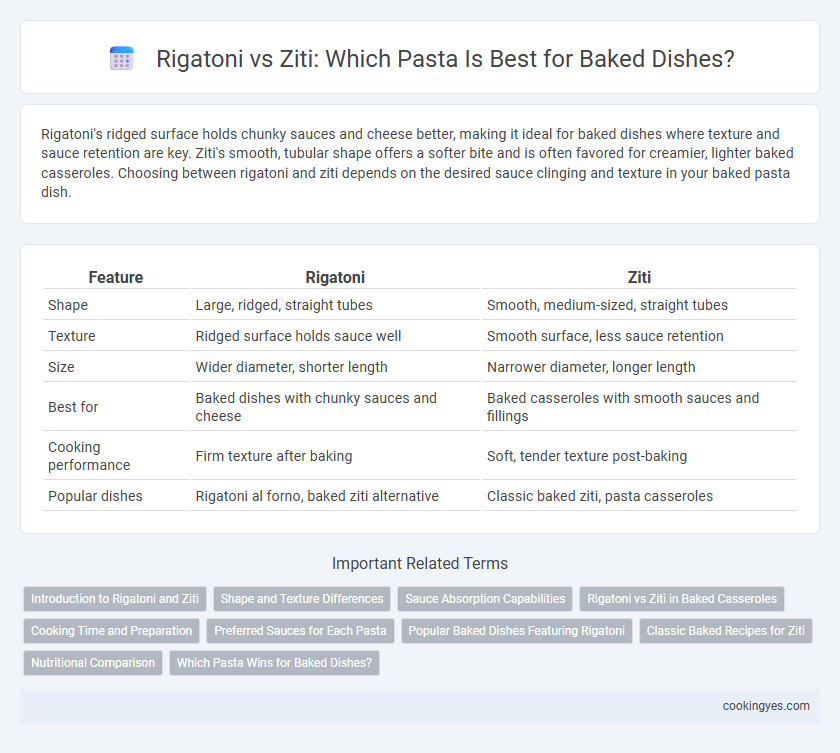Rigatoni's ridged surface holds chunky sauces and cheese better, making it ideal for baked dishes where texture and sauce retention are key. Ziti's smooth, tubular shape offers a softer bite and is often favored for creamier, lighter baked casseroles. Choosing between rigatoni and ziti depends on the desired sauce clinging and texture in your baked pasta dish.
Table of Comparison
| Feature | Rigatoni | Ziti |
|---|---|---|
| Shape | Large, ridged, straight tubes | Smooth, medium-sized, straight tubes |
| Texture | Ridged surface holds sauce well | Smooth surface, less sauce retention |
| Size | Wider diameter, shorter length | Narrower diameter, longer length |
| Best for | Baked dishes with chunky sauces and cheese | Baked casseroles with smooth sauces and fillings |
| Cooking performance | Firm texture after baking | Soft, tender texture post-baking |
| Popular dishes | Rigatoni al forno, baked ziti alternative | Classic baked ziti, pasta casseroles |
Introduction to Rigatoni and Ziti
Rigatoni and Ziti are both traditional Italian pasta shapes commonly used in baked dishes, with rigatoni featuring ridged, large tubular shapes that hold sauces well, while ziti are smooth, medium-sized tubes known for their tender texture. Their structural differences influence sauce absorption and texture, making rigatoni ideal for hearty, chunky sauces, whereas ziti is preferred for smoother, creamier baked recipes. Understanding these characteristics enhances the choice of pasta in classic dishes like baked ziti or rigatoni alla Norma.
Shape and Texture Differences
Rigatoni features ridged, tube-shaped pasta with a wider diameter and ridges that hold sauce effectively, making it ideal for baked dishes needing more surface area for cheese and sauce adhesion. Ziti has a smoother, narrower tubular shape with a slightly curved form, creating a softer texture that allows for easier layering and a creamier bite in baked casseroles. The robust texture of rigatoni provides a hearty chew and structural integrity when baked, compared to the more delicate, tender bite of ziti which absorbs sauce differently.
Sauce Absorption Capabilities
Rigatoni's ridged surface and large tubular shape excel at capturing thick baked sauces, allowing each piece to be richly coated and infused with flavor. Ziti, while smoother and slightly smaller, tends to hold sauce primarily inside its hollow center, offering a more uniform but less textured sauce experience. For baked dishes requiring hearty sauce absorption and a robust texture, rigatoni provides superior performance compared to ziti.
Rigatoni vs Ziti in Baked Casseroles
Rigatoni's ridged surface and large diameter make it ideal for baked casseroles, as it holds thick sauces and cheese well without becoming mushy. Ziti, while smoother and slightly thinner, bakes evenly but may not retain chunky ingredients as effectively as rigatoni. Choosing rigatoni over ziti in baked dishes enhances texture and sauce absorption, leading to a heartier casserole experience.
Cooking Time and Preparation
Rigatoni and ziti are both popular pasta choices for baked dishes, with rigatoni's ridged surface helping sauce cling better, enhancing flavor absorption during cooking. Rigatoni generally requires 12-15 minutes boiling time before baking, while ziti cooks slightly faster at around 10-12 minutes, making it more suitable for quicker preparation. When baking, rigatoni's rigid tube structure holds up well to longer oven times, whereas ziti's smooth surface may become softer faster, affecting texture in prolonged baking.
Preferred Sauces for Each Pasta
Rigatoni's ridged, tube-shaped structure excels at holding thick, chunky sauces like meat ragu or vegetable bolognese, making it ideal for baked dishes rich in texture and flavor. Ziti's smooth and slightly smaller tubes pair best with smooth, creamy sauces such as bechamel or ricotta mixtures, allowing for even coating and melt-in-your-mouth consistency. Baked ziti typically features a blend of tomato and cheese-based sauces, while baked rigatoni showcases robust ragu or robust marinara for a hearty, textured bite.
Popular Baked Dishes Featuring Rigatoni
Rigatoni's ridged surface and large, hollow center make it ideal for baked dishes like Rigatoni alla Vodka and Baked Rigatoni with Sausage, as these textures hold rich sauces and cheese perfectly. Unlike ziti, rigatoni maintains its firmness during baking, preventing sogginess in dishes such as Rigatoni al Forno. The pasta's tube shape traps flavorful ingredients, enhancing the overall taste experience in classic Italian casseroles.
Classic Baked Recipes for Ziti
Ziti is ideal for classic baked dishes due to its smooth, tubular shape that holds sauces and cheese evenly, creating a balanced bite. Unlike rigatoni, ziti's hollow structure allows for a creamy texture and a tender interior in baked ziti recipes. Traditional baked ziti often combines ricotta, mozzarella, and marinara sauce, resulting in a rich and comforting dish perfect for family meals.
Nutritional Comparison
Rigatoni and Ziti offer similar nutritional profiles, with both providing approximately 200 calories and 7 grams of protein per cooked cup, but Rigatoni's ridged surface can hold more sauce, potentially adding more flavor and moisture to baked dishes. Ziti's smooth texture contributes to a slightly lighter calorie count when baked without heavy sauces, making it ideal for recipes focused on lighter nutrition. Both pastas are low in fat and cholesterol-free, supporting heart-healthy meals when paired with nutrient-dense ingredients like vegetables and lean proteins.
Which Pasta Wins for Baked Dishes?
Rigatoni's ridged surface and larger diameter allow it to hold thick sauces and cheese better in baked dishes, creating a hearty, flavorful bite. Ziti, with its smooth, tubular shape, offers a slightly lighter texture but tends to release sauce more quickly when baked. For baked pasta dishes like casseroles or baked ziti, rigatoni wins by delivering a more robust texture and sauce retention, enhancing the overall eating experience.
Rigatoni vs Ziti for Baked Dishes Infographic

 cookingyes.com
cookingyes.com